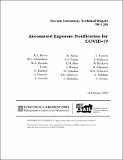| dc.contributor.author | Rivest, Ronald | |
| dc.contributor.author | Schiefelbein, M. Curran | |
| dc.contributor.author | Zissman, Marc A. | |
| dc.contributor.author | Bay, Jason | |
| dc.contributor.author | Bugnion, Edouard | |
| dc.contributor.author | Finnerty, Jill | |
| dc.contributor.author | Liccardi, Ilaria | |
| dc.contributor.author | Nelson, Brad | |
| dc.contributor.author | Norige, Adam S. | |
| dc.contributor.author | Shen, Emily H. | |
| dc.contributor.author | Wanger, Jenny | |
| dc.contributor.author | Yahalom, Raphael | |
| dc.contributor.author | Alekseyev, Jesslyn D. | |
| dc.contributor.author | Brubaker, Chad | |
| dc.contributor.author | Ferretti, Luca | |
| dc.contributor.author | Ishikawa, Charlie | |
| dc.contributor.author | Raykova, Mariana | |
| dc.contributor.author | Schlaman, Brendan | |
| dc.contributor.author | Schwartz, Robert X. | |
| dc.contributor.author | Sudduth, Emma | |
| dc.contributor.author | Tessaro, Stefano | |
| dc.date.accessioned | 2023-02-22T17:36:33Z | |
| dc.date.available | 2023-02-22T17:36:33Z | |
| dc.date.issued | 2023-02-22 | |
| dc.identifier.uri | https://hdl.handle.net/1721.1/148149 | |
| dc.description | The authors were among the 70+ in-person and virtual participants in the October 2021 ImPACT 2021 workshop. This final report has been heavily influenced by the discussion at that workshop. | en_US |
| dc.description.abstract | Private Automated Contact Tracing (PACT) was a collaborative team and effort formed during the beginning of the Coronavirus Disease 2019 (COVID-19) pandemic. PACT’s mission was to enhance contact tracing in pandemic response by designing exposure-detection functions in personal digital communication devices that have maximal public health utility while preserving privacy. PACT had four major lines of effort: proximity detection efficacy, privacy, public health integration, and public health efficacy. In support of these lines of effort, PACT executed several cross-layer activities that helped demonstrate public health efficacy. These included prototype development and demonstrations; system analysis; data collection and experimentation; and large-scale deployment support. PACT convened two scientific workshops relating to privacy-preserving AEN: one virtual workshop in April 2020 and a second hybrid workshop in October 2021. This report is an outcome of the second workshop and serves as PACT’s final report. It seeks to explain and discuss the use of automated exposure notification during the COVID-19 pandemic and to provide some recommendations for those who may try to design and deploy similar technologies in future pandemics. | en_US |
| dc.description.sponsorship | IBM Research, the U.S. Defense Advanced Research Projects Agency (DARPA), and the U.S. Centers for Disease Control and Prevention (CDC). | en_US |
| dc.language.iso | en_US | en_US |
| dc.relation.ispartofseries | Lincoln Laboratory Technical Report;TR-1288 | |
| dc.subject | COVID-19 | en_US |
| dc.subject | exposure notification | en_US |
| dc.subject | contact tracing | en_US |
| dc.subject | digital health | en_US |
| dc.subject | public health | en_US |
| dc.subject | GAEN | en_US |
| dc.subject | privacy | en_US |
| dc.subject | secure multiparty computation | en_US |
| dc.subject | differential privacy | en_US |
| dc.subject | Bluetooth | en_US |
| dc.subject | BLE | en_US |
| dc.subject | SARS-CoV-2 | en_US |
| dc.subject | pandemic | en_US |
| dc.subject | governance | en_US |
| dc.subject | adoption | en_US |
| dc.subject | trust | en_US |
| dc.subject | PACT | en_US |
| dc.subject | proximity | en_US |
| dc.subject | TCFTL | en_US |
| dc.subject | smartphone | en_US |
| dc.subject | AEN | en_US |
| dc.subject | impact | en_US |
| dc.title | Automated Exposure Notification for COVID-19 | en_US |
| dc.type | Technical Report | en_US |
